The Effect of Training in the Preparatory and Competitive Periods on Trunk Rotational Power in Canoeists, Ice-Hockey Players, and Tennis Players
Abstract
:1. Introduction
2. Materials and Methods
2.1. Participants
2.2. Training and Testing
- -
- warm up: 5 min of rope skipping,
- -
- resistance exercises (repetitions × sets × rest): back squat (6 × 3 × 90 s), bench press (8 × 3 × 90 s), parallel bars push-up with an additional load (6 × 3 × 90 s), sit-ups with 5 kg medicine ball (20 × 3 × 60 s), seated lat pulldown (8 × 3 × 90 s), seated row (8 × 3 × 90 s), seated shoulder dumbbells press (8 × 3 × 90 s),
- -
- cooldown: 5 min of stretching.
- -
- warm up: 5 min of cycling,
- -
- resistance exercises (repetitions × sets × rest): one leg squat (10 × 3 × 90 s), push up (15 × 3 × 90 s), lunge (20 × 3 × 60 s), chin to bar (8 × 3 × 90 s), squat to jump (10 × 3 × 90 s),
- -
- cooldown: 5 min of stretching.
2.3. Statistical Analyses
3. Results
4. Discussion
5. Conclusions
Supplementary Materials
Author Contributions
Funding
Acknowledgments
Conflicts of Interest
References
- Richardson, C.A.; Jull, G.A.; Hodges, P.W.; Hides, J.A. Therapeutic Exercise for Spinal Segmental Stabilization in Low Back Pain: Scientific Basis and Clinical Approach; Churchill Livingstone: Edinburgh, NY, USA, 1999. [Google Scholar]
- Kibler, W.B.; Press, J.; Sciascia, A. The role of core stability in athletic function. Sports Med. 2006, 36, 189–198. [Google Scholar] [CrossRef] [PubMed]
- Hibbs, A.E.; Thompson, K.G.; French, D.; Wrigley, A.; Spears, I. Optimizing performance by improving core stability and core strength. Sports Med. 2008, 38, 995–1008. [Google Scholar] [CrossRef] [PubMed]
- Reed, C.A.; Ford, K.R.; Myer, G.D.; Hewett, T.E. The effects of isolated and integrated ‘core stability’ training on athletic performance measures: A systematic review. Sports Med. 2012, 42, 697–706. [Google Scholar] [CrossRef] [PubMed]
- Akuthota, V.; Nadler, S.F. Core strengthening. Arch. Phys. Med. Rehabil. 2004, 85, S86–S92. [Google Scholar] [CrossRef] [PubMed]
- Hill, J.; Leiszler, M. Review and role of plyometrics and core rehabilitation in competitive sport. Curr. Sports Med. Rep. 2011, 10, 345–351. [Google Scholar] [CrossRef] [PubMed]
- Behm, D.G.; Drinkwater, E.J.; Willardson, J.M.; Cowley, P.M. The use of instability to train the core musculature. Appl. Physiol. Nutr. Metab. 2010, 35, 91–108. [Google Scholar] [CrossRef] [PubMed]
- Faries, M.D.; Greenwood, M. Core training: Stabilizing the confusion. Strength Cond. J. 2007, 29, 10–25. [Google Scholar] [CrossRef]
- Balague, F.; Bibbo, E.; Melot, C.; Szpalski, M.; Gunzburg, R.; Keller, T.S. The association between isoinertial trunk muscle performance and low back pain in male adolescents. Eur. Spine J. 2010, 19, 624–632. [Google Scholar] [CrossRef] [PubMed]
- Gomez, T.; Beach, G.; Cooke, C.; Hrudey, W.; Goyert, P. Normative database for trunk range of motion, strength, velocity, and endurance with the Isostation B-200 Lumbar Dynamometer. Spine 1991, 16, 15–21. [Google Scholar] [CrossRef] [PubMed]
- Parnianpour, M.; Nordin, M.; Kahanovitz, N.; Frankel, V. The triaxial coupling of torque generation of trunk muscles during isometric exertions and the effect of fatiguing isoinertial movements on the motor output and movement patterns. Spine 1988, 13, 982–992. [Google Scholar] [CrossRef] [PubMed]
- Flory, P.D.; Rivenburgh, D.W.; Stinson, J.T. Isokinetic back testing in the athlete. Clin. Sports Med. 1993, 12, 529–546. [Google Scholar] [PubMed]
- McGill, S.M.; Childs, A.; Liebenson, C. Endurance times for low back stabilization exercises: Clinical targets for testing and training from a normal database. Arch. Phys. Med. Rehabil. 1999, 80, 941–944. [Google Scholar] [CrossRef]
- Nesser, T.W.; Huxel, K.C.; Tincher, J.L.; Okada, T. The relationship between core stability and performance in division I football players. J. Strength Cond. Res. 2008, 22, 1750–1754. [Google Scholar] [CrossRef] [PubMed]
- Sato, K.; Mokha, M. Does core strength training influence running kinetics, lower-extremity stability, and 5000-M performance in runners? J. Strength Cond. Res. 2009, 23, 133–140. [Google Scholar] [CrossRef] [PubMed]
- Schibek, J.S.; Guskiewicz, K.M.; Prentice, W.E.; Mays, S.; Davis, J.M. The Effect of Core Stabilization Training on Functional Performance in Swimming. Master’s Thesis, University of North Carolina, Chapel Hill, CA, USA, 2001. [Google Scholar]
- Stanton, R.; Reaburn, P.R.; Humphries, B. The effect of short-term Swiss ball training on core stability and running economy. J. Strength Cond. Res. 2004, 18, 522–528. [Google Scholar] [PubMed]
- Tse, M.A.; McManus, A.M.; Masters, R.S. Development and validation of a core endurance intervention program: Implications for performance in college-age rowers. J. Strength Cond. Res. 2005, 19, 547–552. [Google Scholar] [CrossRef] [PubMed]
- Shinkle, J.; Nesser, T.W.; Demchak, T.J.; McMannus, D.M. Effect of core strength on the measure of power in the extremities. J. Strength Cond. Res. 2012, 26, 373–380. [Google Scholar] [CrossRef] [PubMed]
- Abt, J.P.; Smoliga, J.M.; Brick, M.J.; Jolly, J.T.; Lephart, S.M.; Fu, F.H. Relationship between cycling mechanics and core stability. J. Strength Cond. Res. 2007, 21, 1300–1304. [Google Scholar] [PubMed]
- Aguinaldo, A.L.; Buttermore, J.; Chambers, H. Effects of upper trunk rotation on shoulder joint torque among baseball pitchers of various levels. J. Appl. Biomech. 2007, 23, 42–51. [Google Scholar] [CrossRef] [PubMed]
- Brown, E.W.; Abani, K. Kinematics and kinetics of the dead lift in adolescent power lifters. Med. Sci. Sports Exerc. 1985, 17, 554–566. [Google Scholar] [CrossRef] [PubMed]
- Cholewicki, J.; VanVliet, J.J. Relative contribution of trunk muscles to the stability of the lumbar spine during isometric exertions. Clin. Biomech. 2002, 17, 99–105. [Google Scholar] [CrossRef]
- Ellenbecker, T.S.; Roetert, E.P. An isokinetic profile of trunk rotation strength in elite tennis players. Med. Sci. Sports Exerc. 2004, 36, 1959–1963. [Google Scholar] [CrossRef] [PubMed]
- Stodden, D.F.; Fleisig, G.S.; McLean, S.P.; Lyman, S.L.; Andrews, J.R. Relationship of pelvis and upper torso kinematics to pitched baseball velocity. J. Appl. Biomech. 2001, 17, 164–172. [Google Scholar] [CrossRef]
- Thelen, D.G.; Ashton-Miller, J.A.; Schultz, A.B. Lumbar muscle activities in rapid three-dimensional pulling tasks. Spine 1996, 21, 605–613. [Google Scholar] [CrossRef] [PubMed]
- Watkins, R.G.; Uppal, G.S.; Perry, J.; Pink, M.; Dinsay, J.M. Dynamic electromyographic analysis of trunk musculature in professional golfers. Am. J. Sports Med. 1996, 24, 535–538. [Google Scholar] [CrossRef] [PubMed]
- Tihanyi, J.; Apor, P.; Fekete, G. Force-velocity-power characteristics and fiber composition in human knee extensor muscles. Eur. J. Appl. Physiol. Occup. Physiol. 1982, 48, 331–343. [Google Scholar] [CrossRef] [PubMed]
- Hamar, D. Monitoring of power in the weight room. In Proceedings of the 6th International Conference on Resistance Training, Colorado Springs, CO, USA, 30 October–2 November 2008; pp. 355–359. [Google Scholar]
- Zemková, E.; Jeleň, M.; Poór, O.; Hamar, D. Peak power outputs during trunk rotations occur at light to moderate weights, depending on sports speacilization of athletes. In Proceedings of the 22nd Annual Congress of the European College of Sport Science, MetropolisRuhr, Germany, 5–8 July 2017; p. 397. [Google Scholar]
- Poór, O. Muscle power and velocity during trunk rotations after 6 weeks of training in canoeists. In Proceedings of the Student Research Conference 2017, Bratislava, Slovakia, 9–12 July 2017; pp. 105–112. [Google Scholar]
- Poór, O.; Glevaňák, D.; Zemková, E. Muscle power and velocity during trunk rotations after 6 weeks of training in ice-hockey players. Acta Fac. Educ. Phys. Univ. Comen. 2017, 57, 85–91. [Google Scholar] [CrossRef]
- Baechle, T.R.; Earle, R.W. Essentials of Strength Training and Conditioning; Human Kinetics: Champaign, IL, USA, 2000. [Google Scholar]
- Zemková, E.; Jeleň, M.; Zapletalová, L.; Hamar, D. Muscle power during standing and seated trunk rotations with different weights. Sport Mont. 2017, 15, 17–23. [Google Scholar] [CrossRef]
- Zemková, E.; Jeleň, M.; Ollé, G.; Chren, M.; Olej, P.; Štefanovský, M.; Zapletalová, L.; Žiška, J.; Hamar, D. Mean power and velocity in acceleration phase of trunk rotation in athletes with different explosive force production capacity. In Proceedings of the 19th Annual Congress of the European College of Sport Science, Amsterdam, The Netherlands, 2–5 July 2014; p. 268. [Google Scholar]
- Zemková, E.; Jeleň, M.; Ollé, G.; Hamar, D. Mean velocity of trunk rotation discriminates athletes with different sport-related demands. Eur. J. Sports Med. 2013, 1, 216. [Google Scholar]
- Sahrmann, S. Diagnosis and Treatment of Movement Impairment Syndromes; Mosby: St. Louis, MO, USA, 2002. [Google Scholar]
- Earp, J.E.; Kraemer, W.J. Medicine ball training implications for rotational power sports. Strength Cond. Res. 2010, 32, 20–25. [Google Scholar] [CrossRef]
- Putnam, C.A. Sequential motions of body segments in striking and throwing skills: Descriptions and explanations. J. Biomech. 1993, 26, 125–135. [Google Scholar] [CrossRef]

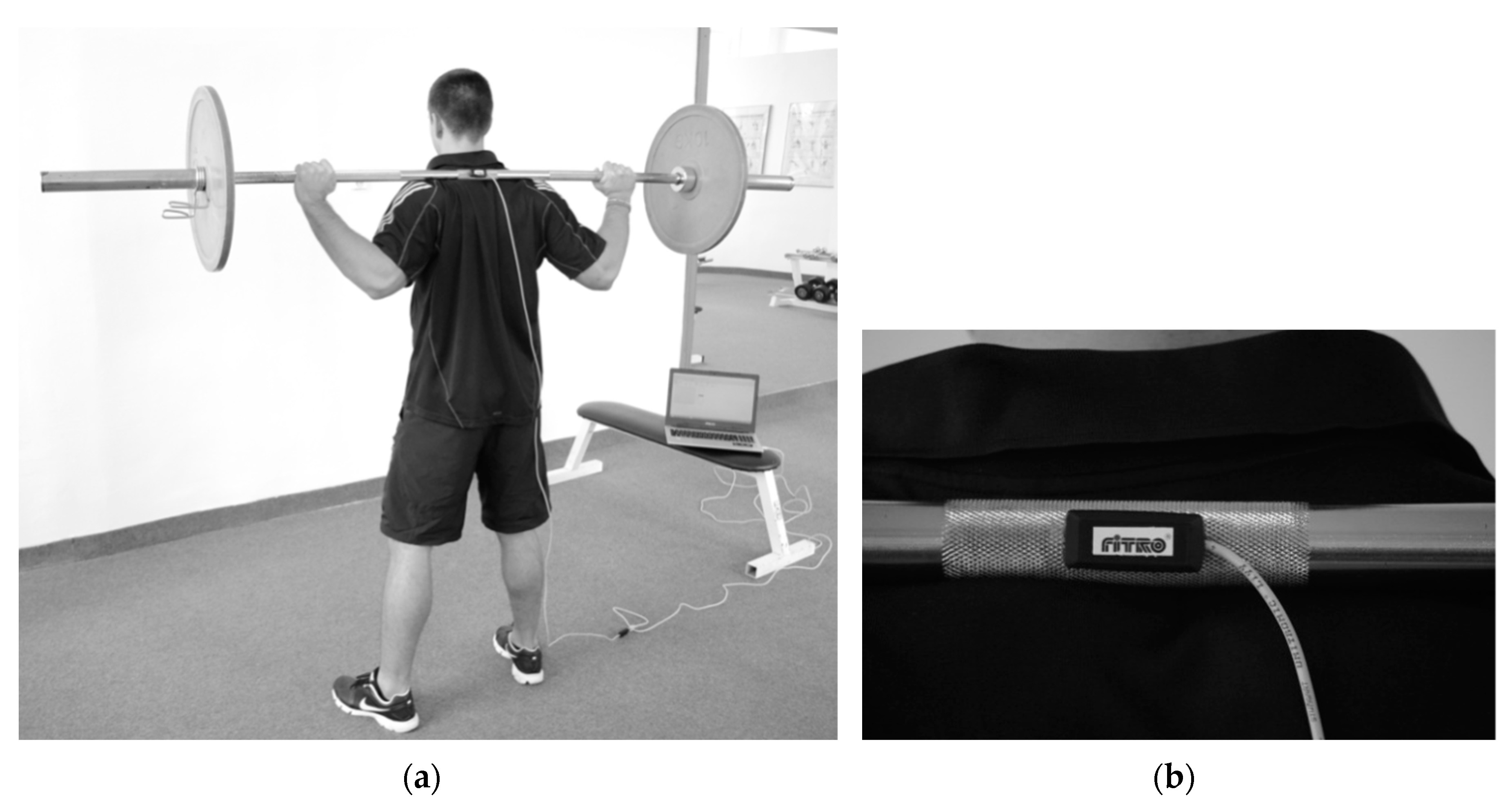

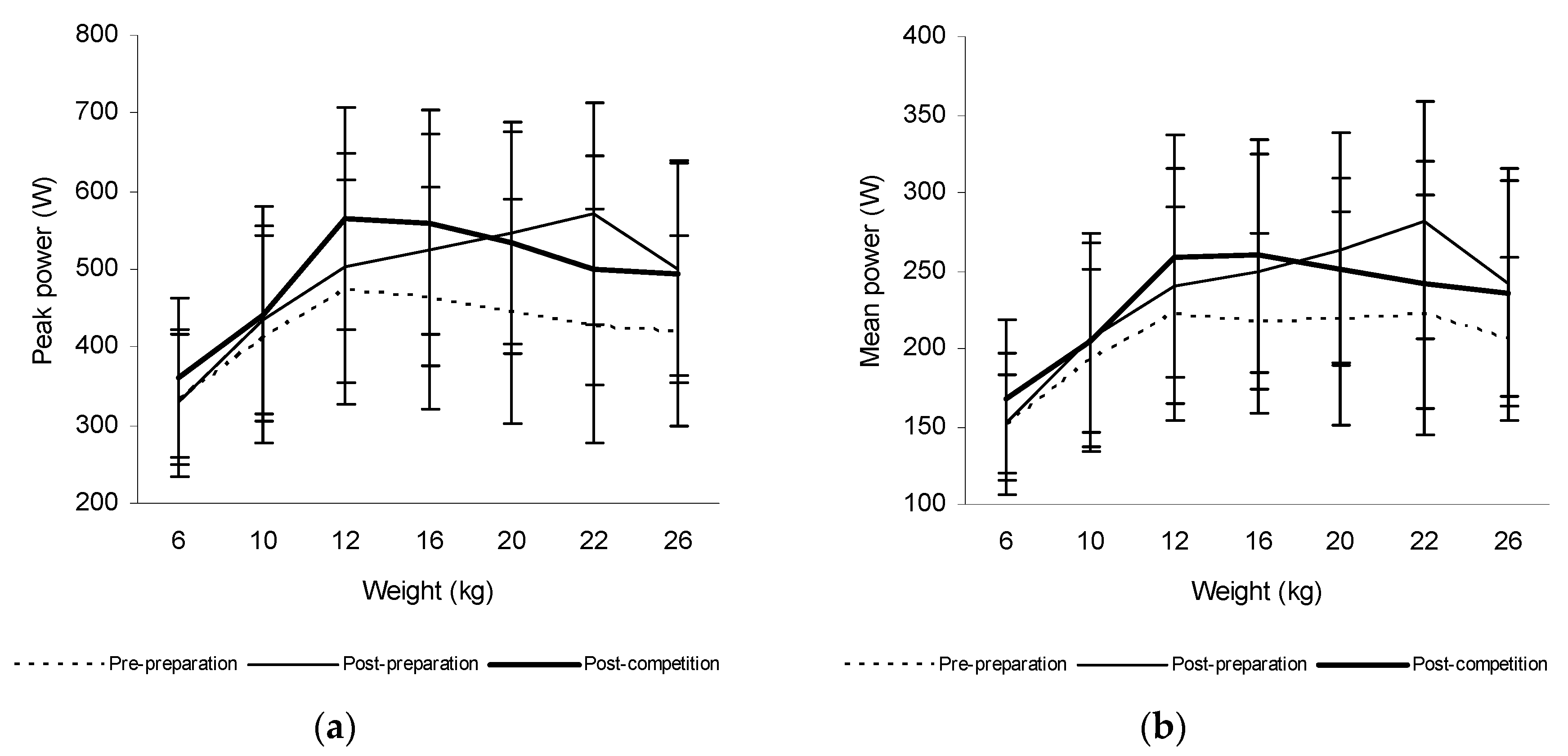
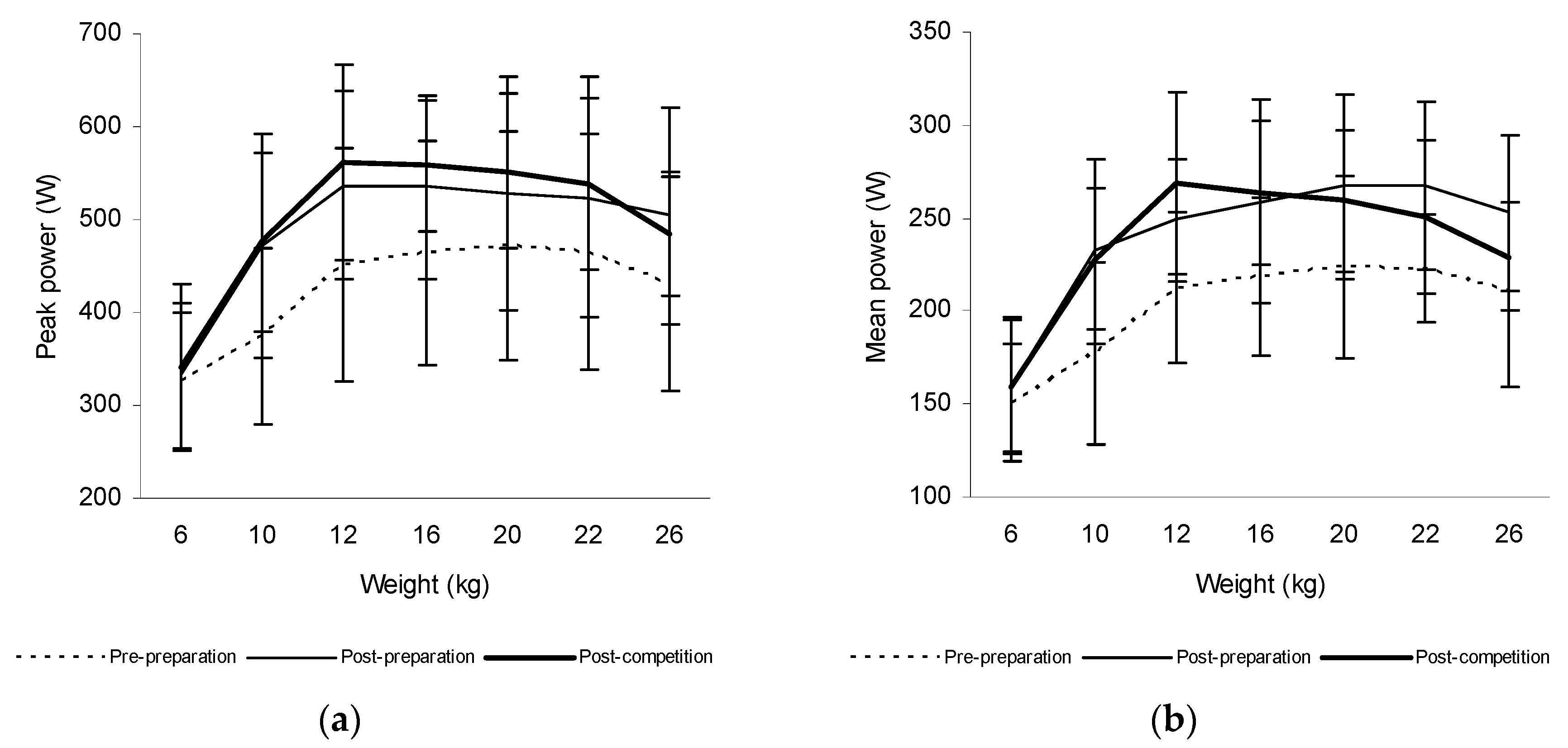
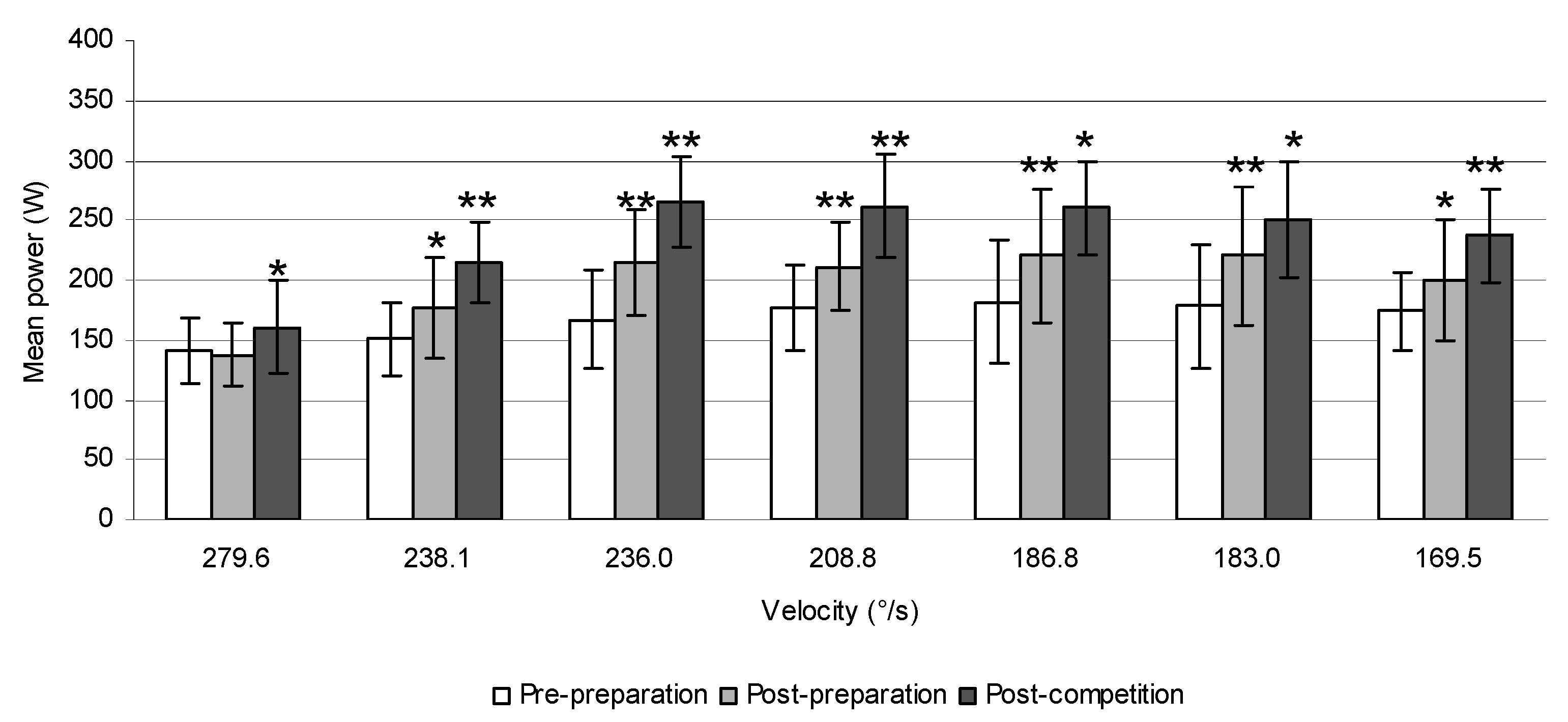
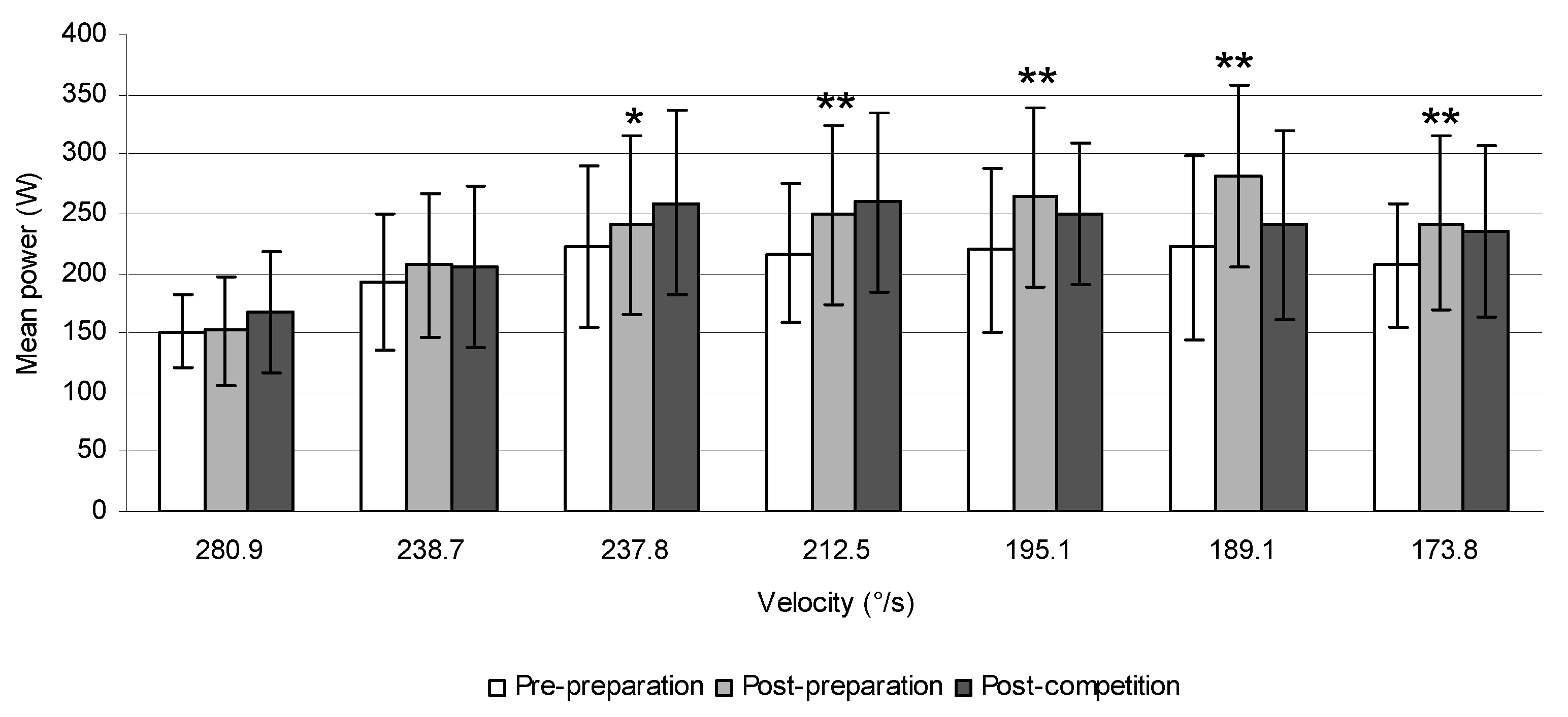

| Groups of Athletes | N | Years of Competition | Level of Competition | Years of Experience with Resistance Training | Age (years) | Height (cm) | Body Mass (kg) |
|---|---|---|---|---|---|---|---|
| Canoeists | 8 | 7.7 ± 3.4 | International, World championships | 3.7 ± 1.8 | 21.0 ± 1.9 | 181.1 ± 5.5 | 78.8 ± 13.6 |
| Ice-hockey players | 15 | 14.6 ± 1.4 | National league | 6.9 ± 2.0 | 19.9 ± 1.1 | 182.7 ± 4.6 | 81.2 ± 5.7 |
| Tennis players | 7 | 6.0 ± 2.4 | Amateur, Regional tournaments | 5.4 ± 3.0 | 25.9 ± 1.1 | 178.6 ± 4.1 | 76.0 ± 6.4 |
| Tennis Players | Monday | Tuesday | Wednesday | Thursday | Friday | Saturday | Sunday |
| Morning or afternoon | Strength training | Strength training | Tennis game | Strength training | Fitness training | Tennis game | Tennis game |
| General/specific training (minutes) | 60/0 | 60/0 | 0/60 | 60/0 | 30/0 | - | - |
| Ice-Hockey Players | Monday | Tuesday | Wednesday | Thursday | Friday | Saturday | Sunday |
| Morning (M) | Strength training | Strength training | - | Strength training | - | Individual physical activities | No training |
| Afternoon (A) | Fitness games; Endurance and agility training | Fitness games; Strength and agility training | Swimming | Fitness games; Agility training | Outdoor cycling | - | No training |
| General/specific training (minutes) | 75(M) + 120(A)/0 | 75(M) + 120(A)/0 | 120(A)/0 | 75(M) + 120(A)/0 | 120(A)/0 | - | - |
| Canoeists | Monday | Tuesday | Wednesday | Thursday | Friday | Saturday | Sunday |
| Morning or afternoon | Strength training | Strength training | No training | Strength training | Active recovery phase | No training | Active recovery phase |
| General/specific training (minutes) | 90/0 | 90/0 | - | 90/0 | 60/0 | - | 90/0 |
| Tennis Players | Monday | Tuesday | Wednesday | Thursday | Friday | Saturday | Sunday |
| Morning or afternoon | Active recovery phase | Tennis game | Active recovery phase | Tennis game | Active recovery phase | Tennis match | Tennis match |
| General/specific training (minutes) | 60/0 | 0/60 | 60/0 | 0/60 | 60/0 | - | - |
| Ice-Hockey Players | Monday | Tuesday | Wednesday | Thursday | Friday | Saturday | Sunday |
| Morning (M) | - | Fitness training; Ice-hockey training | - | - | - | - | - |
| Afternoon (A) | Ice-hockey training; Strength training | Active recovery phase | Ice-hockey training; Strength training | Ice-hockey training; Upstairs running | Ice-hockey training; Strength training | Hockey match | Hockey match |
| General/specific training (minutes) | 30(A)/75 | 60(M)/15 | 30(A)/60 | 30(A)/75 | 30(A)/45 | - | - |
| Canoeists | Monday | Tuesday | Wednesday | Thursday | Friday | Saturday | Sunday |
| Morning or afternoon | Canoeing training | Strength training | Canoeing training | Strength training | Canoeing training | Canoeing training | No training |
| General/specific training (minutes) | 0/120 | 60/0 | 0/120 | 60/0 | 0/120 | 0/120 | - |
© 2018 by the authors. Licensee MDPI, Basel, Switzerland. This article is an open access article distributed under the terms and conditions of the Creative Commons Attribution (CC BY) license (http://creativecommons.org/licenses/by/4.0/).
Share and Cite
Poór, O.; Zemková, E. The Effect of Training in the Preparatory and Competitive Periods on Trunk Rotational Power in Canoeists, Ice-Hockey Players, and Tennis Players. Sports 2018, 6, 113. https://doi.org/10.3390/sports6040113
Poór O, Zemková E. The Effect of Training in the Preparatory and Competitive Periods on Trunk Rotational Power in Canoeists, Ice-Hockey Players, and Tennis Players. Sports. 2018; 6(4):113. https://doi.org/10.3390/sports6040113
Chicago/Turabian StylePoór, Oliver, and Erika Zemková. 2018. "The Effect of Training in the Preparatory and Competitive Periods on Trunk Rotational Power in Canoeists, Ice-Hockey Players, and Tennis Players" Sports 6, no. 4: 113. https://doi.org/10.3390/sports6040113
APA StylePoór, O., & Zemková, E. (2018). The Effect of Training in the Preparatory and Competitive Periods on Trunk Rotational Power in Canoeists, Ice-Hockey Players, and Tennis Players. Sports, 6(4), 113. https://doi.org/10.3390/sports6040113






